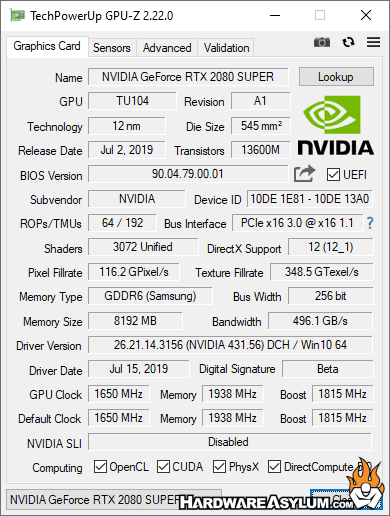Nvidia GeForce RTX 2080 Super Video Card Review
Author: Dennis GarciaBenchmark Configuration
MSI X299 Gaming Pro Carbon – X299 Chipset
Intel Core i9 7900x (3.0Ghz) Ten Core 10 x 1MB L2 Cache 13MB L3 Cache
Thermaltake Water 2.0 Extreme
4x Corsair Vengeance LPX PC4-21300 16GB DDR4 (15-17-17-35)
Crucial MX300 750GB SSD
HP dvd1260i Multiformat 24x Writer
Thermaltake Toughpower Grand 1050 Watt PSU
Windows 10 Pro 64bit
Drivers
NVIDIA RTX 2080 Super (431.56)
ZOTAC RTX 2080 AMP Extreme (417.01)
NVIDIA GTX 1080 Ti Founders Edition (417.01)

Framerates were captured using the included benchmarking software or captured game data. The settings used for each test will be listed on the individual benchmarking page with the average framerate recorded in the charts. When possible only the GPU scores are recorded giving the best opportunity for repeatable results.
The purpose of our benchmark suite is to provide the readers with a comparative analysis of video card performance based on a common set of variables. This may not always reflect a real "in-game" experience or framerates, since those are almost impossible to replicate, but instead is designed to provide an accurate scale of performance of one video card to another given their default setting.
I also want to mention that very few of these benchmarks focus on Ray Tracing or DLSS. Much like with PhysX it is just a technology that has been enabled on a certain hardware platform. In this case Ray Tracing and DLSS only run on RTX video cards and are only enabled in a few select games and benchmarks.

